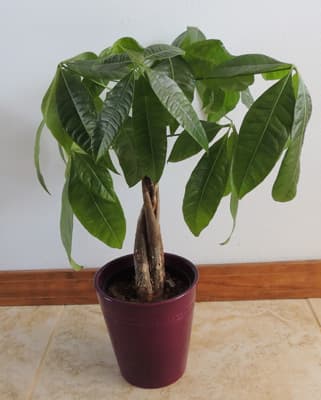How to Grow Money Tree Plants

About Growing Money Tree Houseplants
Who said money doesn’t grow on trees!? Eager to dispel this old saying, my wife purchased a Money Tree plant a few years ago. Then, ever since she has been waiting for this attractive plant to produce a profusion of fifty and one hundred dollars bills. To date, it has yet to sprout so much as a penny. Fortunately for the tree, is an attractive and low-maintenance houseplant. Are you ready to start growing some money? Growing the Money Tree houseplant is easy!
There’s another benefit to having this plant in your home. It is believed to bring good luck and good fortune to anyone who grows it in their home or office.
Native to Central and South America, the Money Tree can grow up to 60 feet outdoors. Perhaps the most attractive feature is its braided trunk. It has palmate, five-leaved stems. The leaves are a glossy green. The Money Tree produces showy flowers with long petals. The flower gives way to a nut that is a brownish color. The nut is edible, raw or roasted. It has a chestnut-like flavor. On larger trees, the nut can grow up to 12 inches long! The plant seeds are inside the nut.
This tropical, wetland tree can be found naturally near swamps in frost-free regions. It is a member of the Mallow family. Most Money Trees are grown as indoor houseplants and usually do not reach over 10 feet tall. You can find them growing in homes and offices. And, they are popular in shopping malls. They look great in bonsai gardens. Used as a Bonsai plant, they are kept much smaller.
Note: Do not confuse the Money Tree with the Money Plant (Lunaria). The Money Plant is a flower on a much thinner stem.
Money Tree Plant Specifics
Botanical name: Pachira Aquatica
Plant Height: Outdoors this tree can grow up to 60 feet tall.
Blooming Period: Outdoors in the Spring
Flower Colors: White and yellow.
Plant Hardiness Zone: 10 – 12
Ideal Soil pH: 6.5 – 7.5
The Legend of the Money Tree
There’s an ancient legend about the money tree. A man once prayed for money. Shortly after making this plea, he began to grow trees from one that was already growing in his field. Sales of the tree took off and he became rich. So, he named it the “Money Tree”.
It is also believed that this tree can bring good fortune. Most of the stems have five or six glossy green leaves. Occasionally, you may find seven leaves on a stem. Similar to finding a four-leaf clover, finding seven leaves on a stem will bring you good luck.
Today’s Quote: “I’d like to live as a poor man with lots of money.” – – Pablo Picasso
Money Tree Plant Propagation
New plants can be started from seed, or from cuttings. For cuttings, snip off the growing tip of the plant, leaving two leaf nodes on the cutting. Root the cutting in moist potting soil. Use the container that will be the young plants’ permanent home. Do not root it in water as the cutting can rot. It takes several weeks for the new roots to develop.
Money Tree Light Requirements
Your money tree plant requires six or more hours of sunlight per day. For those of us living in colder northern regions of the country, it means we become “Sun Chasers”, moving our plants from window to window to capture as much sunlight as possible. For homeowners, this becomes impractical as the plant grows.
Money trees grown in malls do not usually have this problem as many of the malls have glass roofs to let in sunlight.
How to Grow Money Trees
Money trees are easy to grow as houseplants. They like light, well-draining soil. Use a combination of peat moss, and perlite or lose sand to help with drainage. Plant them in smaller containers, which have a hole in the bottom for drainage.
Water the plants thoroughly, then allow the top inch or two of the soil to dry in between watering.
Fertilize every two weeks during spring and summer, with a solution of liquid fertilizer. During the winter months, give it less fertilizer.
The plants like high humidity, over 50%.
Do not allow the plant to get rootbound. After a few years, the tree will outgrow its container. Transplant to a larger flowerpot as needed.
Insects and Plant Disease
Common insect problems include Aphids, Gnats, and Mealybugs.
Plant diseases include Anthracnose and Powdery mildew.
Root rot can be a problem in wet soils. Allow the top inch or two of the soil to completely dry out between watering. The trunk can also rot. Avoid getting water on the trunks.
Related Articles
Also, people who read this article will like:
How to Grow Houseplants – Indoor plant care
Please support our site. Shop for:
- rmmatthews100@hotmail.com
- 585-721-6528
- Rochester, NY
©1999-2024 GardenersNet.Com, All Rights Reserved

